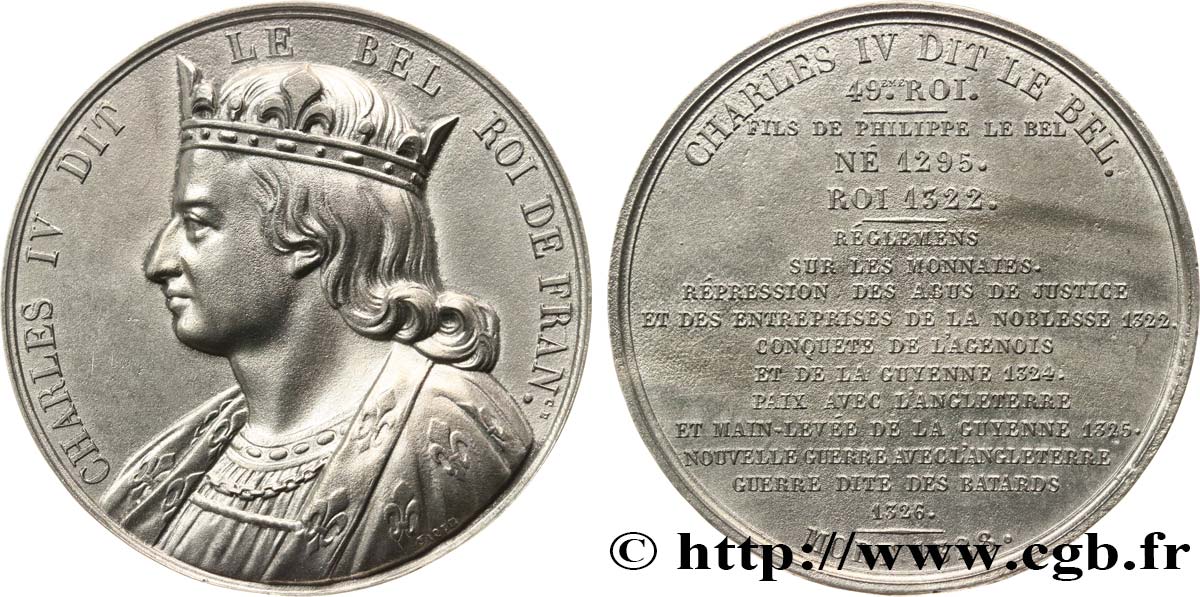fme_620585 - LOUIS-PHILIPPE I Médaille du roi Charles IV le Bel
66.00 €约 502.26 CNY
数量
加入购物车

种类 Médaille du roi Charles IV le Bel
日期: 1322-1328
材质 tin
直径 52 mm
模子方针 12 h.
硬币制模工 CAQUÉ Armand Auguste (1795-1881)
重量 54,34 g.
侧面 lisse
印模 sans poinçon
关于品相的说明
Patine hétérogène avec quelques taches noires. Aspect légèrement poreux
出版目录中的项代码 :
正面
正面的文字 CHARLES IV DIT LE BEL ROI DE FRANCE.
正面的说明书 Buste couronné à gauche de Charles IV le Bel.
背面
背面的文字 CHARLES IV DIT LE BEL / 49EME ROI / - / FILS DE PHILIPPE LE BEL / NE 1295. / ROI 1322. / - / REGLEMENS / SUR LES MONNAIES. / REPRESSION DES ABUS DE JUSTICE / ET DES ENTREPRISES DE LA NOBLESSE 1322. / CONQUETE DE L’AGENOIS / ET DE LA GUYENNE 1324. / ET MAIN-LEVEE DE LA GUENNE 1325. / NOUVELLE GUERRE AVEC L’ANGLETERRE / GUERRE DITE DES BATARDS / 1326. / - / MORT 1328..
背面的说明书 Légende en 17 lignes.
评论
Intéressante médaille signée Caqué et non datée. Elle fait partie de la série de 73 médailles gravées de 1835 à 1840 par Caqué.
Armand Auguste Caqué, né à Saintes (Charente-Inférieure) le 24 janvier 1795 et mort à Paris le 31 décembre 1881 à l'âge de 86 ans, est un sculpteur, graveur et médailleur français. Graveur officiel de l'empereur Napoléon III. Ses médailles sont signées CAQUÉ F et quelquefois sa signature est suivie de la mention "Graveur de S. M. l'Empereur".
Charles IV, dit le Bel (château de Creil, 18 juin 1294-Vincennes, 1er février 1328), roi de France et de Navarre de 1322 à 1328, est le dernier souverain français de la dynastie dite des Capétiens directs. Après sa mort sans descendance mâle, la couronne française passe à ses cousins, les Valois, tandis que la couronne navarraise passe à sa nièce Jeanne.
Armand Auguste Caqué, né à Saintes (Charente-Inférieure) le 24 janvier 1795 et mort à Paris le 31 décembre 1881 à l'âge de 86 ans, est un sculpteur, graveur et médailleur français. Graveur officiel de l'empereur Napoléon III. Ses médailles sont signées CAQUÉ F et quelquefois sa signature est suivie de la mention "Graveur de S. M. l'Empereur".
Charles IV, dit le Bel (château de Creil, 18 juin 1294-Vincennes, 1er février 1328), roi de France et de Navarre de 1322 à 1328, est le dernier souverain français de la dynastie dite des Capétiens directs. Après sa mort sans descendance mâle, la couronne française passe à ses cousins, les Valois, tandis que la couronne navarraise passe à sa nièce Jeanne.








 对产品描述纠错
对产品描述纠错 打印
打印 分享我的选择
分享我的选择 提问
提问 Consign / sell
Consign / sell
 产品介绍
产品介绍










